25 Best Native Plants for Ocala, FL
BY KIMBERLY MAGERL | APRIL 3RD, 2023 | FLORIDA, LAWN CARE, OCALAOcala is a picturesque city full of rolling hills, champion horses, and thoroughbred farms. It is home to the Ocala National Forest with over 430,000 acres of wildlife, lakes, rivers, and botanical diversity, making it easy to see many of the over 4,700 species of plants native to Florida live in their habitats. After seeing these beautiful plants, consider adding some to your Florida lawn for a low-maintenance landscape.
Native plants offer many benefits, including:
- They provide food and shelter for local wildlife, birds, and insects to support a diverse ecosystem.
- They are acclimated to the subtropical climate, are salt-tolerant, require less water, and are adapted to sandy, acidic soils.
- They are low-maintenance, surviving local pests and diseases.
Native plants promote a healthier Florida ecosystem. Check out these 25 native plants for Ocala to create a diverse landscape in your own backyard.
In this article, we’ll cover:
- 25 Best Native Plants for Your Ocala Yard
- Azalea
- Beautyberry
- Black-Eyed Susan
- Butterfly Weed
- Coontie
- Coral Honeysuckle
- Coreopsis
- Elliott’s Aster
- Fakahatchee Grass
- Firebush
- Florida Anise Tree
- Gaillardia
- Muhly Grass
- Oakleaf Hydrangea
- Passion Flower
- Powderpuff Mimosa
- Saw Palmetto
- Scarlet Salvia
- Seagrape
- Southern Live Oak
- Southern Magnolia
- Southern Wax Myrtle
- Star Jasmine
- Walter’s Viburnum
- Yucca
- How to Choose Native Plants for Your Ocala Landscape
- FAQ About Native Ocala Plants
- Where to Find Native Plants in Ocala
25 Best Native Plants for Your Ocala Yard
1. Azalea (Rhododendron)
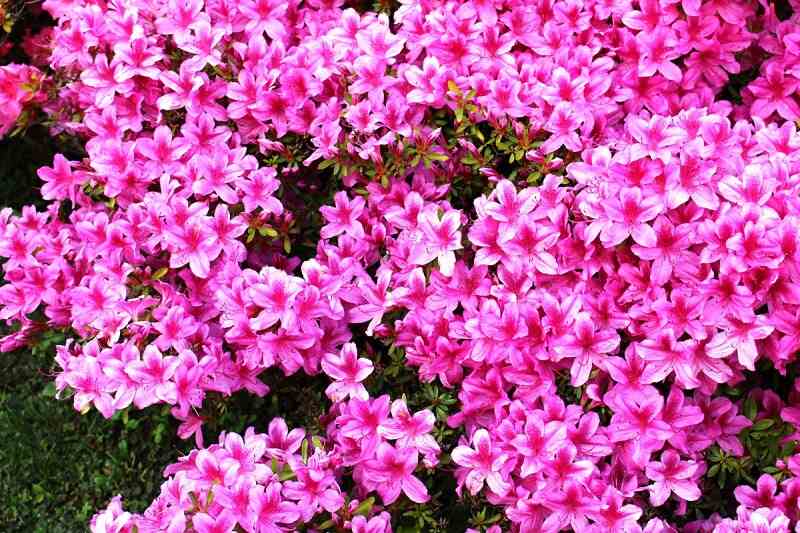
Photo Credit: Pxhere
Azaleas are recognizable for their pink or white flowers lining the flowerbeds of many homes in North Central Florida. However, those particular plants are not native. They are actually hybrid varieties from Japan, Rhododendron indicum.
Florida has its own native azaleas with smaller flowers. These fragrant flowers bloom in spring and range in color from pink to yellow. They are a slow-growing plant, eventually reaching heights up to 10 feet tall. They are low-maintenance shrubs that love partial shade and filtered sunlight. Add native azaleas to your flower beds and butterfly garden to attract pollinators.
Growth habit: Shrub
USDA hardiness zone: 5a-9b
Mature size: 10 feet tall and 8 feet wide
Duration: Perennial
Foliage: Deciduous
Sunlight needs: Partial shade
Soil preferences: Prefers well-drained acidic soil
Water needs: Drought-tolerant; may need weekly watering during extreme dry spells
Potential hazards: Toxic; all plant parts are poisonous to humans and animals if ingested
2. Beautyberry (Callicarpa Americana)
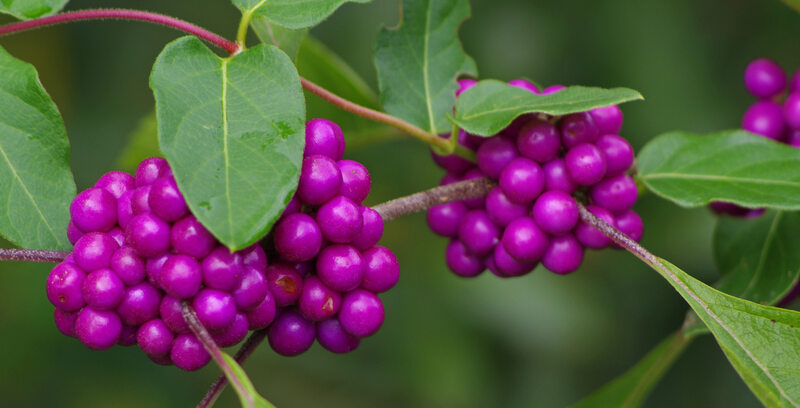
Photo Credit: Virginia State Parks staff / Wikimedia Commons / CC BY-SA 3.0
Beautyberry is a sprawling shrub that works well as a border plant with its long branches arching toward the ground. Also known as American mulberry, its bright purple fruits attract birds and other wildlife. It responds well to pruning for a more compact appearance.
Beautyberry has small lavender flowers and fuzzy, light green leaves. The shrub blooms from spring to summer before maturing to fruits in September. Beautyberry is drought tolerant and adapts well to the acidic, sandy soils of North Central and South Florida.
Growth habit: Shrub
USDA hardiness zone: 7-11
Mature size: 3-8 feet tall and 4-8 feet wide
Duration: Perennial
Foliage: Deciduous
Sunlight needs: Full sun to partial shade
Soil preferences: Adaptable; prefers nutrient-rich soil but tolerates acidic, sandy soil
Water needs: Drought-tolerant; prefers a regular watering schedule and moist roots
Potential hazards: Non-toxic; no safety hazards
3. Black-Eyed Susan (Rudbeckia hirta)
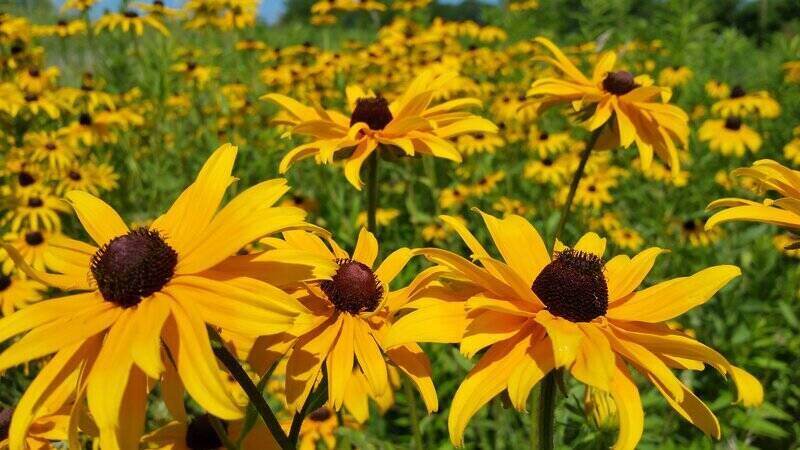
Photo Credit: Pixabay
Black-eyed Susan is a highly recognizable pop of color for Ocala yards. Known for its bright gold petals and dark brown centers, the hardy wildflower is salt and drought-tolerant and makes a great addition to any butterfly garden.
Transplanted flowers or sewn seeds grow well in garden beds and containers. Black-eyed Susan flowers grow atop round, clumping leaves. They love full sun and well-drained soil and work well as cut flowers for an outdoor-to-indoor home display.
Growth habit: Flower
USDA hardiness zone: 3-10
Mature size: 1-3 feet tall and 1-2 feet wide
Duration: Biennial
Foliage: Deciduous
Sunlight needs: Full sun
Soil preferences: Adaptable, prefers acidic soil
Water needs: Drought-tolerant; may need weekly watering during extreme dry spells
Potential hazards: Non-toxic; no safety hazards
4. Butterfly Weed (Asclepias tuberosa)
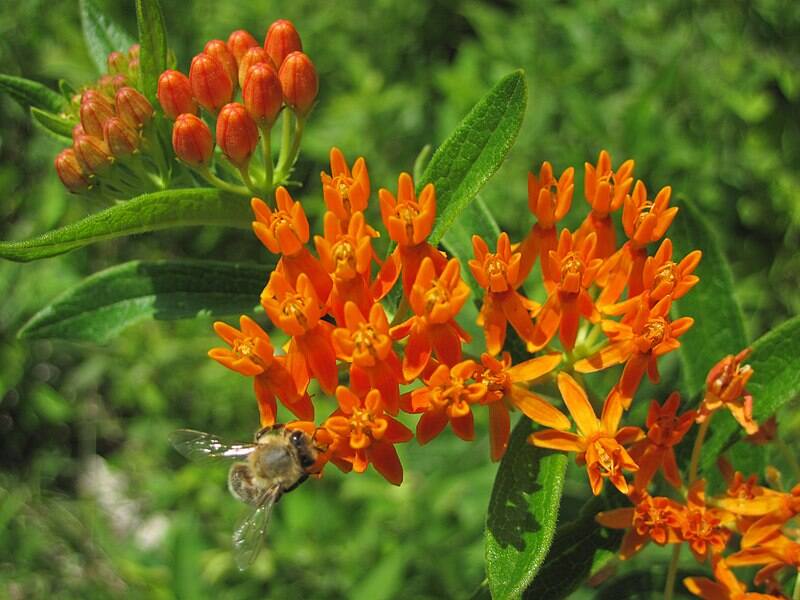
Photo Credit: James St. John / Wikimedia Commons / CC BY 2.0
Some plant species, like milkweed, are vital to healthy Florida landscapes, and over 20 native species call Florida home. Butterfly weed is a native species of milkweed and an attractive flowering plant. It is a nectar source for bees and pollinators and a host plant for caterpillars, including the Monarch butterfly.
Butterfly weed produces bright orange or yellow flowers from summer to fall. The hardy plant loves full sun and tolerates most soils. It is also moderately salt and drought-tolerant.
Growth habit: Flower
USDA hardiness zone: 3-10
Mature size: 1-4 feet tall and less than 1 foot wide
Duration: Perennial, though some species are annuals
Foliage: N/A
Sunlight needs: Full sun
Soil preferences: Prefers dry, sandy soil
Water needs: Semi drought-tolerant; prefers to dry out between waterings
Potential hazards: High toxicity; milky sap poisonous to humans and animals
5. Coontie (Zamia integrifolia)
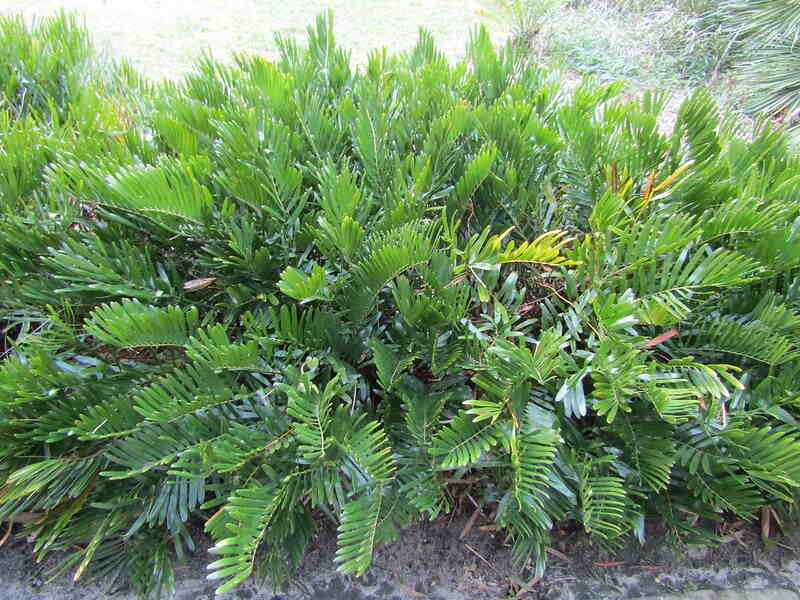
Photo Credit: Leonora (Ellie) Enking / Flickr / CC BY-SA 2.0
Coontie is a member of the cycad family. This clumping groundcover is a seed plant resembling a small fern. Also known as Florida arrowroot, the evergreen plant has ancient roots dating back to the time of the dinosaurs. It is an important member of the Florida ecosystem and the only cycad native to North America. Coontie is the larval food source of the rare Atala butterfly.
The round plant has shiny, feather-shaped leaves attached to a thick stem. It works well as clumping groundcover in many areas of your landscape and is drought, salt, and cold-tolerant. It thrives in both sunny and shady conditions.
Growth habit: Clumping groundcover
USDA hardiness zone: 8-11
Mature size: 2-3 feet tall and 3 feet wide
Duration: Perennial
Foliage: Evergreen
Sunlight needs: Full sun, partial shade, full shade
Soil preferences: Adaptable; prefers well-drained soil
Water needs: Drought-tolerant; prefers to dry out between waterings
Potential hazards: Toxic; seeds are deadly to humans and animals if ingested, and the entire plant is poisonous
6. Coral Honeysuckle (Lonicera sempervirens)
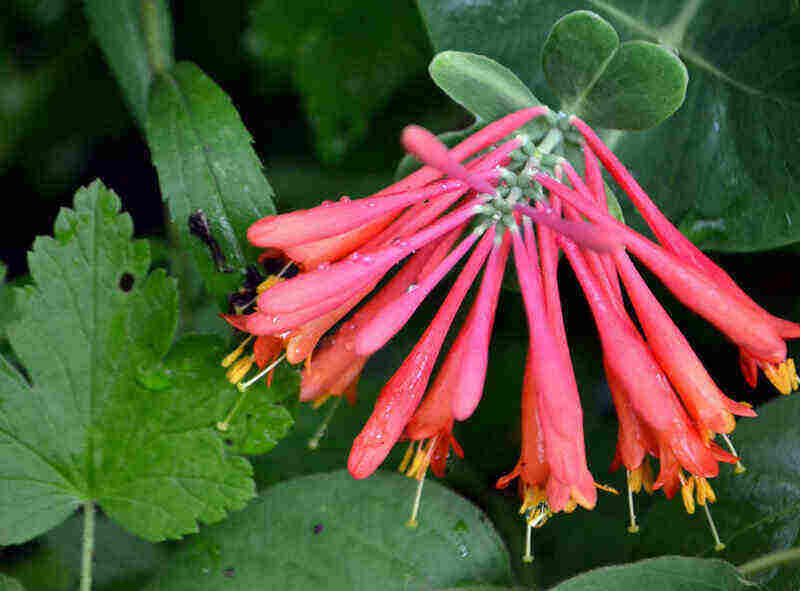
Photo Credit: Jo Naylor / Flickr / CC BY 2.0
Coral honeysuckle is a twining evergreen clumping vine found climbing the woods, sandhills, and flatwoods of Central and South Florida. It blooms year-round and does its best blooming in the winter. You can find it crawling trellises, walls, and fences, reaching heights up to 18 feet.
Trumpet-shaped red-orange flower clusters grow among dark, shiny leaves, giving way to bright red berries from September to October. Coral honeysuckle attracts hummingbirds, songbirds, and other pollinators with its vibrant flowers and fruit.
Growth habit: Vine
USDA hardiness zone: 4-10
Mature size: 3-18 feet
Duration: Perennial
Foliage: Evergreen to semi-evergreen
Sunlight needs: Full sun to partial shade
Soil preferences: Adaptable; prefers well-drained soil
Water needs: Needs about 1 inch of water per week, including rainfall (may need weekly watering during dry spells)
Potential hazards: Toxic to humans and animals if ingested
7. Coreopsis (Coreopsis grandiflora)
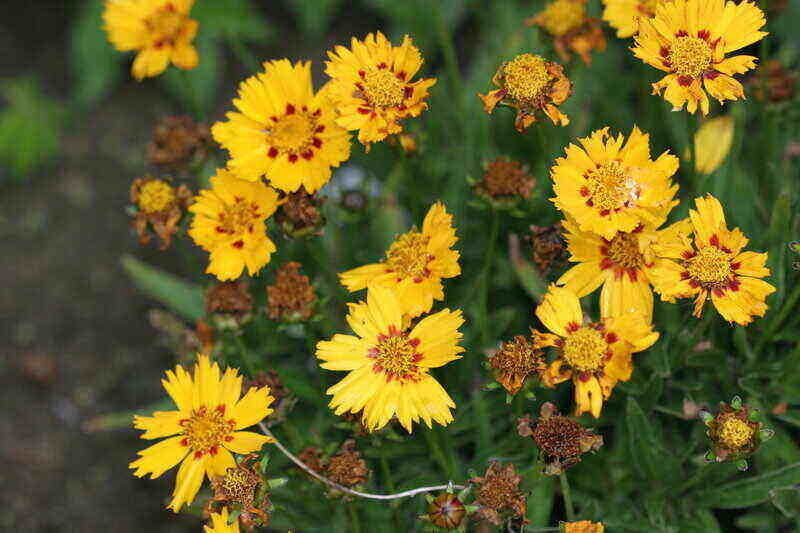
Photo Credit: Andrey Zarkikh / Flickr / CC BY 2.0
Coreopsis is Florida’s state wildflower and a type of aster. Also known as tickseed, the perennial blooms daisy-shaped, yellow flowers with brown-orange centers from spring to summer.
Coreopsis is drought-tolerant and reseeds itself. Its bright blooms attract butterflies and native pollinators. Tickseed makes a great addition to flower beds, containers, and butterfly gardens.
Growth habit: Wildflower
USDA hardiness zone: 4-11
Mature size: 1-4 feet tall and 1-2 feet wide
Duration: Perennial
Foliage: N/A
Sunlight needs: Full sun; tolerate partial shade
Soil preferences: Adaptable; prefers moist, well-drained soil, sand, or loam
Water needs: Drought-tolerant; may need weekly watering during extreme dry spells
Potential hazards: Non-toxic, no safety hazards
8. Elliott’s Aster (Symphyotrichum elliottii)
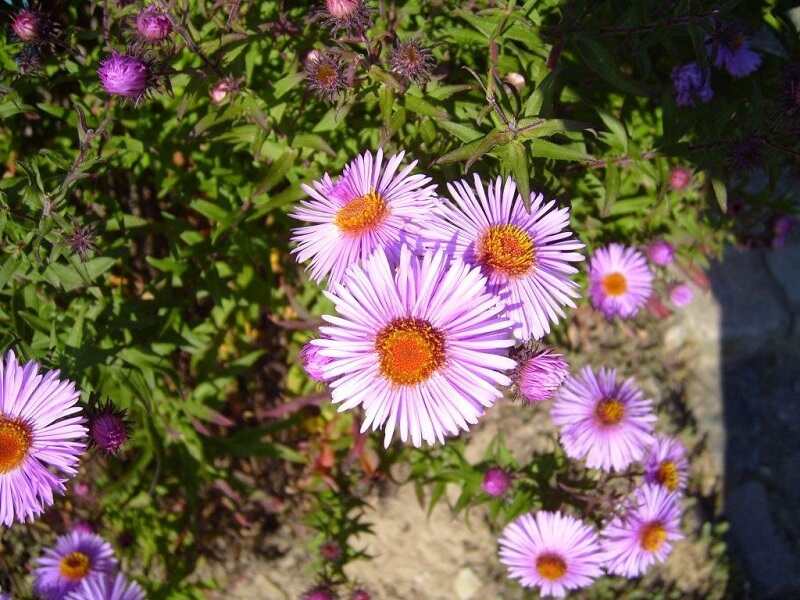
Photo Credit: Titus Tscharntke / Wikimedia Commons / Public Domain
Elliot’s aster is one of 331 native aster species in Florida. It is a perennial with a sprawling shape. It is quick-growing and great for filling gaps in flower beds and pollinator gardens. Elliott’s aster is especially attractive to honey bees.
The delicate flower blooms light purple in late summer to early fall. It loves full sun and a range of soils but does not tolerate salt.
Growth habit: Wildflower
USDA hardiness zone: 8b-10b
Mature size: 3-4 feet tall and 2-3 feet wide
Duration: Perennial
Foliage: N/A
Sunlight needs: Full sun
Soil preferences: Adaptable; prefers moist soil, sand, loam, or clay
Water needs: Moderately drought-tolerant; prefers moist soil
Potential hazards: Non-toxic, edible
9. Fakahatchee Grass (Tripsacum dactyloides)
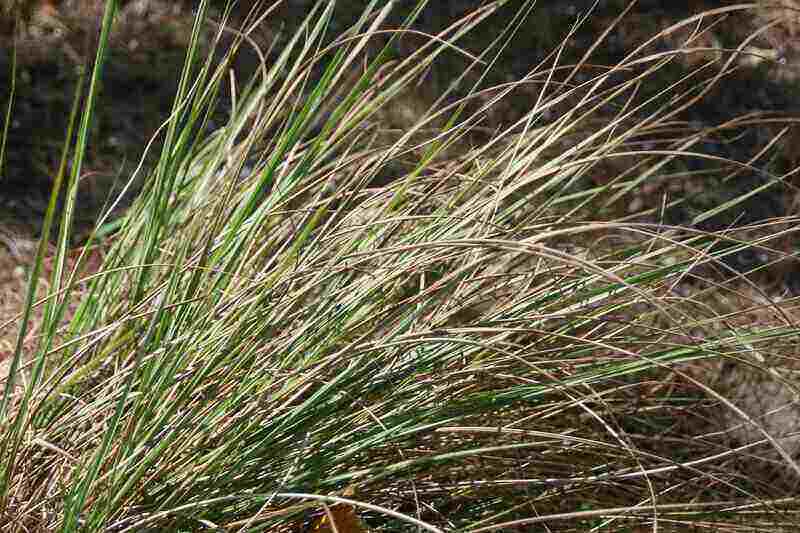
Photo Credit: David J. Stang / Wikimedia Commons / CC BY-SA 3.0
Fakahatchee grass is a clumping plant that makes great ornamental grass for Ocala landscapes. It works well as an accent and border plant. Fakahatchee grass is the food source for the larval Byssus Skipper butterfly. You can find it growing naturally along river banks and swamps in South and Central Florida.
This ornamental grass is easy to grow. It has grass-like foliage and small white, yellow, or pink flowers that bloom in late spring. It grows best in full sun and loves well-drained, moist soil, though it adapts to drier conditions and will survive flooding. Fakahatchee grass responds well to pruning but grows just as well as a low-maintenance plant when left alone.
Growth habit: Ornamental grass
USDA hardiness zone: 8-11
Mature size: 3-4 feet tall and 4-6 feet wide
Duration: Perennial
Foliage: Evergreen to semi-evergreen
Sunlight needs: Partial shade
Soil preferences: Adaptable; well-drained, moist acidic or alkaline soil, sand, loam, clay; extended flooding
Water needs: Moderately drought-tolerant; prefers moist soil
Potential hazards: Non-toxic; no safety hazards
10. Firebush (Hamelia patens)
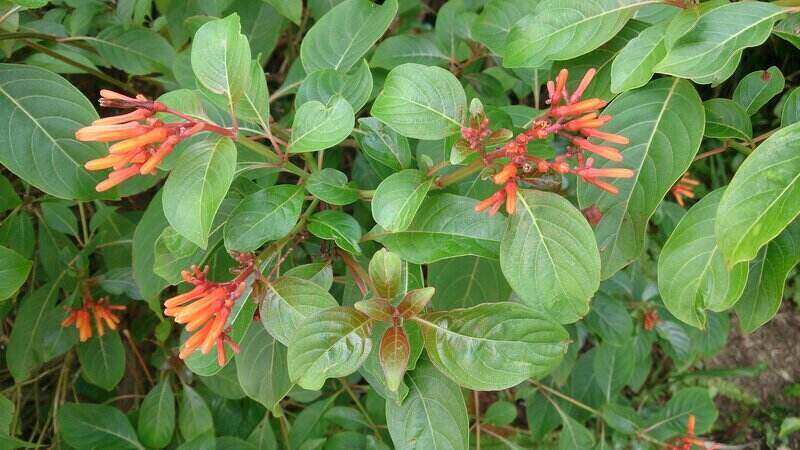
Photo Credit: Mokki / Wikimedia Commons / CC BY-SA 3.0
Firebush has distinctive bright red flowers that bloom from late spring to the first frost. It is a hardy shrub popular with hummingbirds, butterflies, and other local wildlife. Firebush can reach up to 15 feet tall in North Central Florida but responds well to pruning for contained growth.
The semi-woody shrub works well as a standalone shrub, hedgerow, or border plant. The foliage will die if temperatures hit freezing but will regrow in spring. Firebush adapts to most soil conditions and is heat and drought-tolerant with no natural disease or insect threats.
Growth habit: Shrub
USDA hardiness zone: 9-12
Mature size: 6-12 feet tall and 5-8 feet wide
Duration: Perennial
Foliage: Evergreen
Sunlight needs: Full sun, partial shade, full shade
Soil preferences: Adaptable; prefers well-drained soil
Water needs: Drought-tolerant; needs about 1 inch of water per week, including rainfall (may need weekly watering during dry spells)
Potential hazards: Low toxicity; poisonous to humans and animals, though it has a bitter taste most animals avoid
11. Florida Anise Tree (Illicium floridanum)
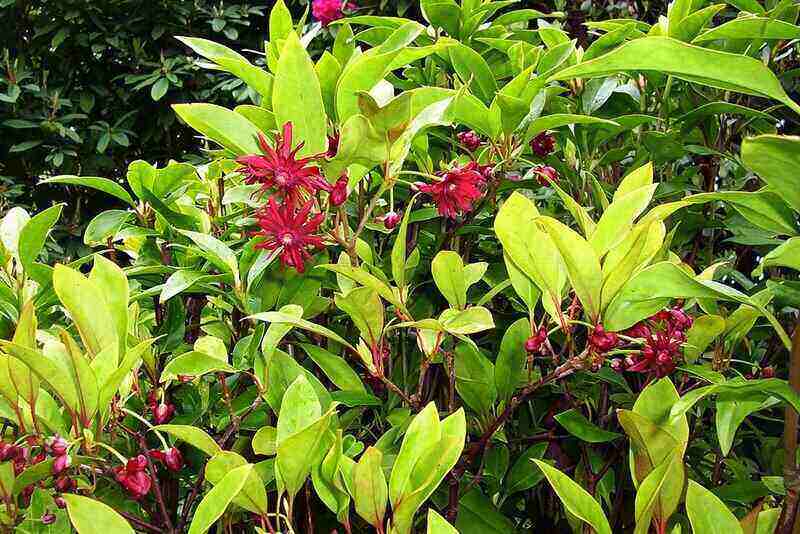
Photo Credit: peganum / Flickr / CC BY-SA 2.0
Purple anise, or the Florida anise tree, is actually an evergreen shrub with small star-shaped purple to red flowers. Its skinny branches droop to the ground, giving the shrub a rounded shape while its flowers bloom in spring with fruits following from late summer to fall. The fruits of the Florida anise tree give off a distinct licorice odor when crushed like its cousin star anise.
Florida anise has a dense growth pattern, making it ideal for windbreaks and hedgerows. They grow well in partial shade but prefer full sun and respond well to pruning. Florida state law protects these low-maintenance evergreen shrubs. They love rich soil and moisture but adapt to most conditions. The purple anise does not tolerate salt water and its foliage is poisonous, making it resistant to insects, deer, and Ocala black bears.
Growth habit: Shrub
USDA hardiness zone: 8-10
Mature size: 10-15 feet tall and 6-10 feet wide
Duration: Perennial
Foliage: Evergreen
Sunlight needs: Full sun to partial shade
Soil preferences: Prefers rich, moist soil, clay, sand, or loam
Water needs: Drought-tolerant; may need weekly watering during extreme dry spells
Potential hazards: Toxic; foliage is poisonous to humans and animals
12. Gaillardia (Gaillardia aestivalis)
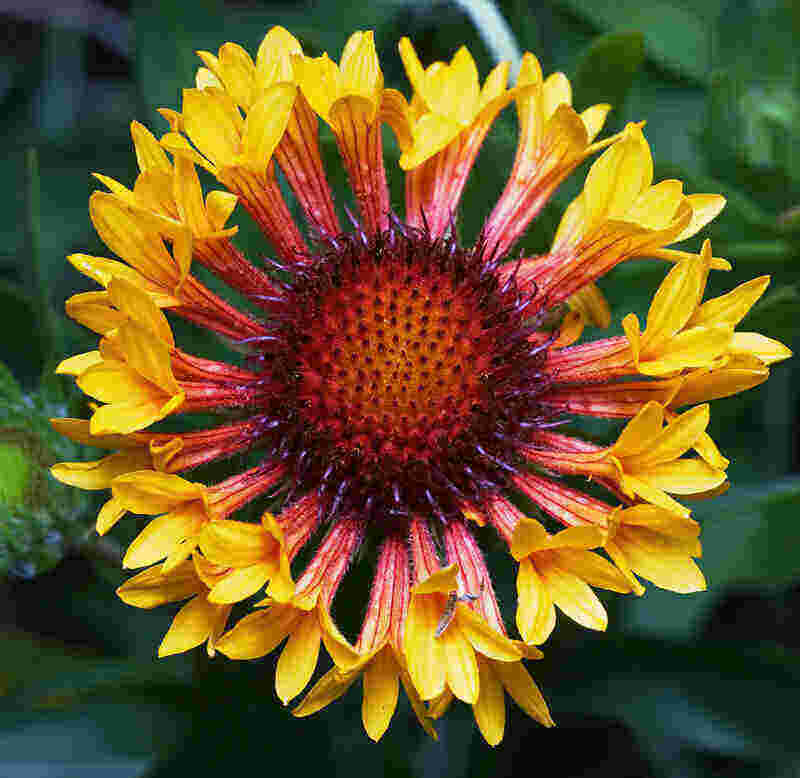
Photo Credit: JJ Harrison / Wikimedia Commons / CC BY-SA 3.0
Experts recently discovered the most popular species of gaillardia, Gaillardia pulchella, also known as blanket flower, is not native to Florida. However, a similar species of gaillardia, Gaillardia aestivalis, or lanceleaf blanket flower, is native to North and Central Florida, making it an excellent choice for your Ocala landscape.
Part of the daisy family, lanceleaf blanket flower is a quick-growing perennial with showy yellow compound blooms appearing from late spring into fall. This clumping plant attracts butterflies and pollinators. Unfortunately, it is short-lived.
Gaillardia aestivalis prefers full sun and well-drained soil. It is drought-tolerant and self sows. This native wildflower makes a great addition to borders, rock gardens, small spaces, containers, and butterfly gardens.
Growth habit: Flower or clumping groundcover
USDA hardiness zone: 3a-10b
Mature size: 1-3 feet tall and up to 2 feet wide
Duration: Short-lived perennial
Foliage: Semi-evergreen
Sunlight needs: Full sun
Soil preferences: Adaptable; well-drained acidic or alkaline soil, sand, rock, or loam
Water needs: Drought-tolerant; may need weekly watering during extreme dry spells
Potential hazards: Non-toxic; no safety hazards
13. Muhly Grass (Muhlenbergia capillaries)
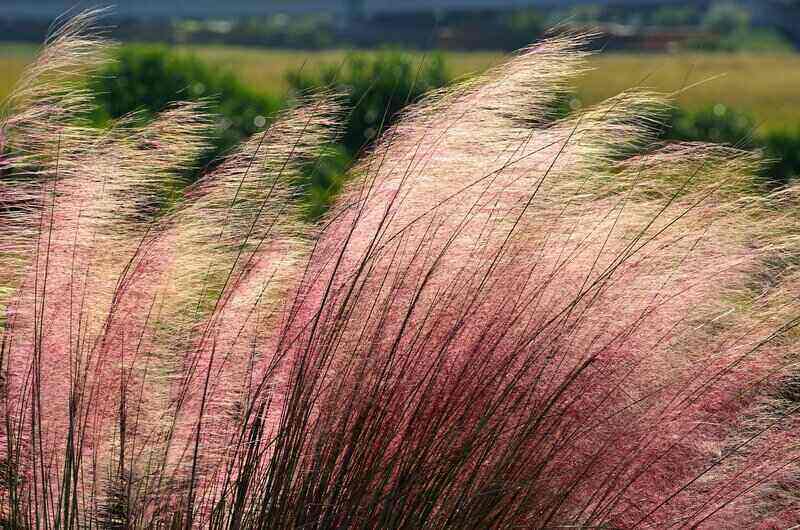
Photo Credit: Pixabay
Muhly grass is one of the most low-maintenance and easy-to-grow options for Ocala landscapes. This ornamental clumping grass lines Florida flatwoods, uplands, and highways, producing fluffy pink flower stalks every fall.
Muhly grass thrives in the sun and is drought-tolerant. The salt-tolerant grass is perfect for flower beds, borders, and low-maintenance mass plantings.
Growth habit: Ornamental grass
USDA hardiness zone: 7-11
Mature size: 3-5 feet tall and 2-3 feet wide
Duration: Perennial
Foliage: Semi-evergreen
Sunlight needs: Full sun
Soil preferences: Adaptable; acidic or alkaline soil, sand, loam, clay; extended flooding
Water needs: Drought-tolerant; may need weekly watering during extreme dry spells
Potential hazards: Non-toxic; no safety hazards
14. Oakleaf Hydrangea (Hydrangea quercifolia)
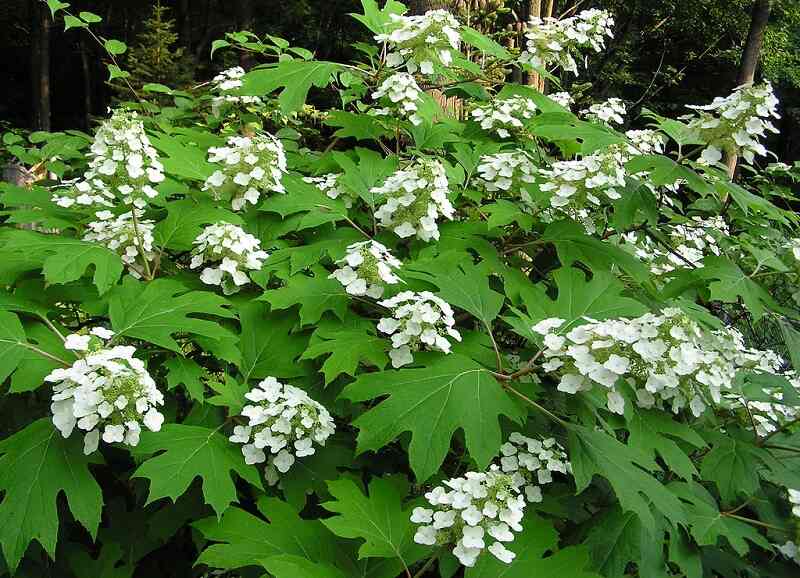
Photo Credit: Anne Norman / Wikimedia Commons / CC BY 2.0
Oakleaf hydrangea is a rare shade-loving shrub found in the understory of large trees like Florida live oaks. It is coarse-textured with large, cone-shaped flower clusters that bloom for months every summer and change colors from white to light pink and purple.
The fast-growing deciduous shrub gets its name from its dark green, oak-shaped leaves that turn red, gold, or purple in the fall. Oakleaf hydrangea reaches heights up to 10 feet tall and thrives in fertile, well-drained soil. Smaller cultivars like “Pee Wee” are available for homeowners with limited space.
Growth habit: Shrub
USDA hardiness zone: 5b-9
Mature size: 6-10 feet high and 6-8 feet wide
Duration: Perennial
Foliage: Deciduous
Sunlight needs: Full shade to partial shade
Soil preferences: Prefers, fertile, well-drained soil; adapts to most soil conditions, including moist, acidic soil
Water needs: Moderately drought-tolerant; prefers moist soil
Potential hazards: Toxic; all plant parts are poisonous to humans and animals
15. Passion Flower (Passiflora incarnate)
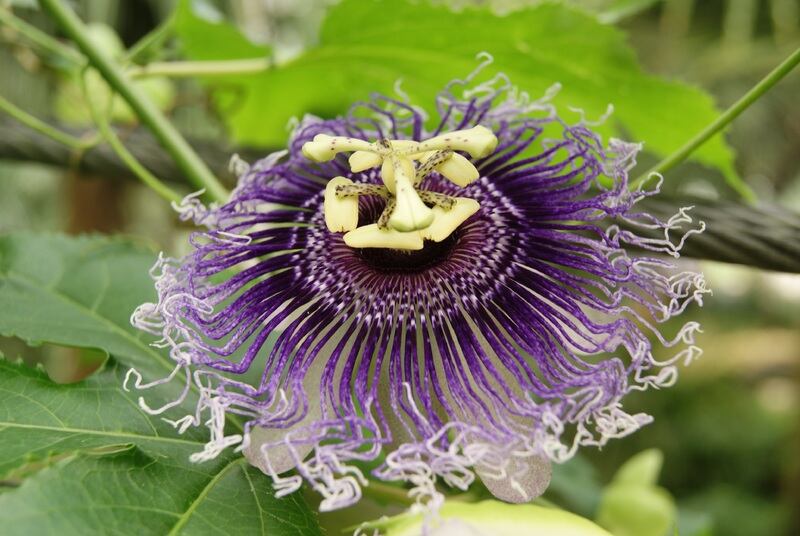
Photo Credit: Pxhere
Passion flower, or maypop, is a flowering vine and butterfly host plant. It is fast-growing, and hardy with dense foliage that provides natural cover for wildlife. Passion flower’s large lavender blooms attract hummingbirds and butterflies. The vine produces edible green fruits, though they are not related to passion fruit and do not taste good.
The perennial vine loves full sun and spreads to occupy a trellis, fence, or archway. Passion flower is pest-resistant and tolerates drought conditions. However, the hardy plant is susceptible to nematode damage in North Central Florida.
Growth habit: Vine
USDA hardiness zone: 6-10
Mature size: Up to 30 feet; spreads to occupy the trellis or fence
Duration: Perennial
Foliage: Evergreen
Sunlight needs: Full sun to partial shade
Soil preferences: Adaptable; prefers moist soil
Water needs: Drought-tolerant; water twice weekly during dry spells
Potential hazards: Non-toxic; safe for humans and animals
16. Powderpuff Mimosa (Mimosa strigillosa)
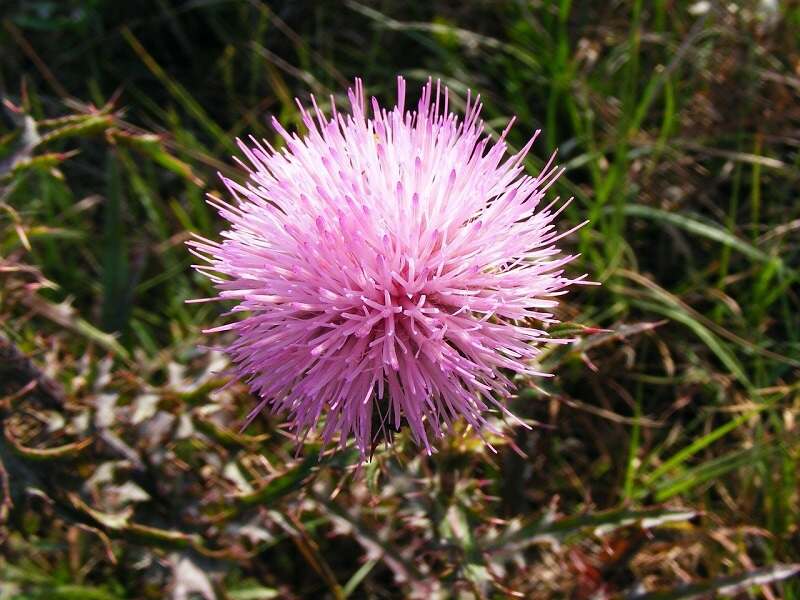
Photo Credit: Pixabay
Powderpuff mimosa is a low-growing, flowering groundcover. Also known as sunshine mimosa, this flowering plant is an important host plant for butterfly larvae. It blooms puffy, pink, ball-shaped flowers from spring through fall among bright-green, fern-shaped leaves.
Powderpuff mimosa withstands light traffic and spreads quickly. However, it is not an aggressive plant and works well with turfgrass and in containers alongside other plants. It helps control landscape erosion, is drought tolerant with deep roots, and grows well in full sun to partial shade.
Growth habit: Ornamental flowering groundcover
USDA hardiness zone: 8b-11
Mature size: Spreading; up to 1 foot tall
Duration: Perennial
Foliage: Evergreen
Sunlight needs: Full sun to partial shade
Soil preferences: Adaptable; acidic or alkaline soil, sand, or loam
Water needs: Drought-tolerant; may need weekly watering during extreme dry spells
Potential hazards: Non-toxic; no safety hazards
17. Saw Palmetto (Serenoa repens)
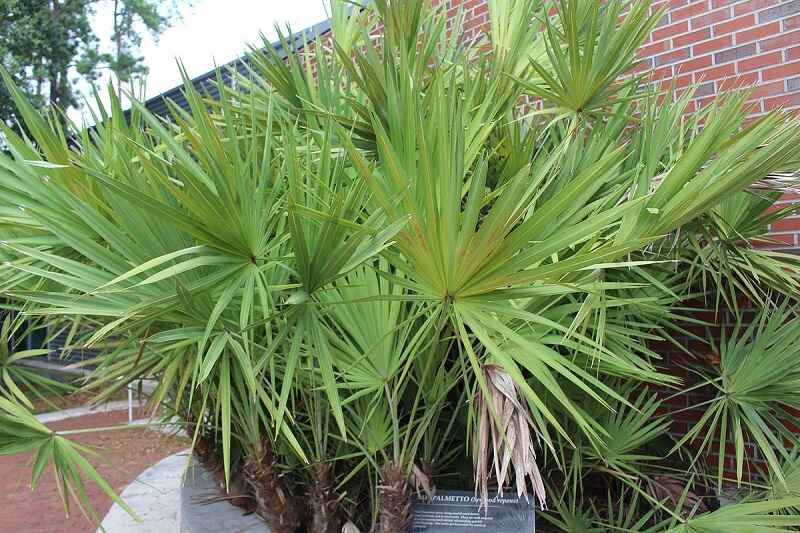
Photo Credit: Michael Rivera / Wikimedia Commons / CC BY-SA 4.0
Saw palmetto is easily recognizable, growing wild throughout Florida. It is a slow-growing, clumping palm that only reaches heights of 5 to 10 feet. Saw palmetto has sprawling, fan-shaped fronds, and tall white flowers bloom on stalks in the spring followed by yellow berries from August to October.
The palm’s berries are an important food source for local wildlife, and some people believe the extract helps cure cancer though there is no scientific evidence. The plant’s popularity as an alternative medicine has led officials to place a harvesting permit requirement on the plant.
Saw Palmetto is the host plant for the Palmetto Skipper and Monk butterflies’ larvae. Saw palmetto grows best in full sun and makes a great addition to mixed borders, privacy hedges, and foundation plants. It is drought-tolerant and low-maintenance.
Growth habit: Palm shrub
USDA hardiness zone: 6-10
Mature size: 5-10 feet tall and 4-10 feet wide
Duration: Perennial
Foliage: Evergreen
Sunlight needs: Full sun to partial shade
Soil preferences: Prefers well-drained, moist soils or seasonally water-logged areas
Water needs: Drought-tolerant; needs about 1 inch of water per week, including rainfall (may need weekly watering during dry spells)
Potential hazards: Non-toxic; no safety hazards
18. Scarlet Salvia (Salvia coccinea)
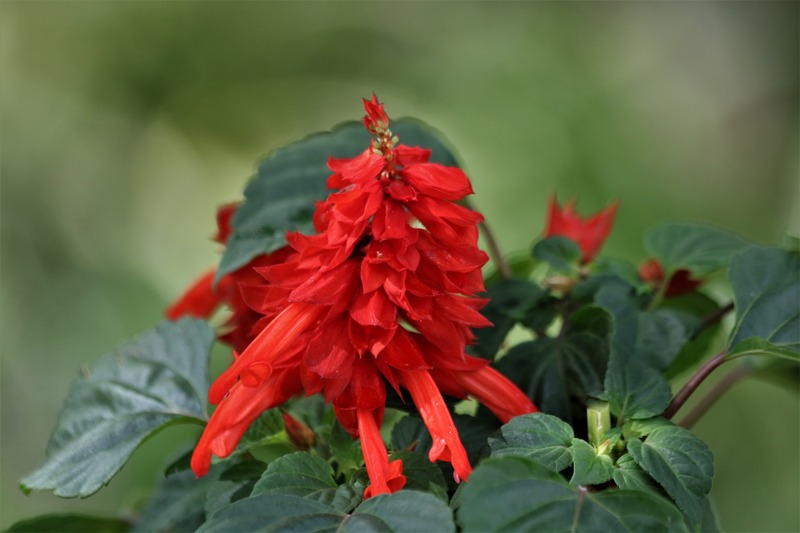
Photo Credit: PublicDomainPictures
Scarlet salvia is an herbaceous perennial with many names, including blood sage, scarlet sage, and tropical sage. It has tubular red flowers that bloom from spring through fall. The attractive plant reaches up to 4 feet tall and attracts Ocala wildlife, hummingbirds, and butterflies.
Scarlet salvia is drought and salt-tolerant. The adaptable plant responds well to pruning and grows well in flower beds, containers, and butterfly gardens.
Growth habit: Herbaceous plant
USDA hardiness zone: 8-11
Mature size: 2-4 feet tall and 1-2 feet wide
Duration: Perennial
Foliage: Semi-evergreen
Sunlight needs: Full sun
Soil preferences: Adaptable; acidic or alkaline soil, sand, or loam
Water needs: Drought-tolerant; may need weekly watering during extreme dry spells
Potential hazards: Non-toxic; no safety hazards
19. Seagrape (Coccoloba uvifera)
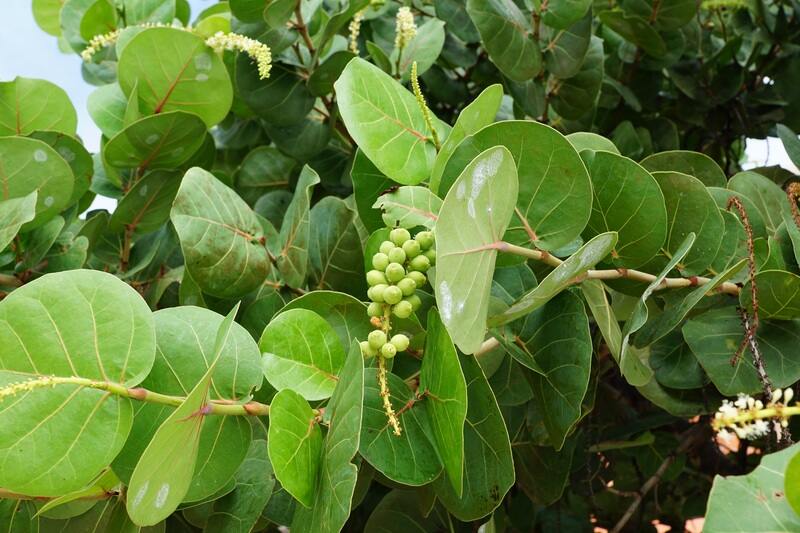
Photo Credit: Pxhere
You can find seagrape growing along Florida’s coasts. It is an endangered and protected shrub that is salt-tolerant. The small tree produces clusters of edible red fruit resembling grapes, clusters of cream-colored flowers, and bright green, round foliage with red veins.
Left unattended, seagrape will grow to 50 feet tall and 30 feet wide but responds well to pruning. These plants work well as hedges, privacy screens, natural windbreaks, and shade trees with attractive, twisted trunks. Seagrape grows well in full or partial sun and sandy, acidic soils. It is very low maintenance except for the occasional pruning.
Growth habit: Tree or shrub
USDA hardiness zone: 10a-11
Mature size: 35-50 feet tall and 20-30 feet wide
Duration: Perennial
Foliage: Evergreen
Sunlight needs: Full sun to partial shade
Soil preferences: Adaptable; prefers well-drained soil
Water needs: Drought-tolerant; needs about 1 inch of water per week, including rainfall
Potential hazards: Non-toxic; edible fruits
20. Southern Live Oak (Quercus virginiana)
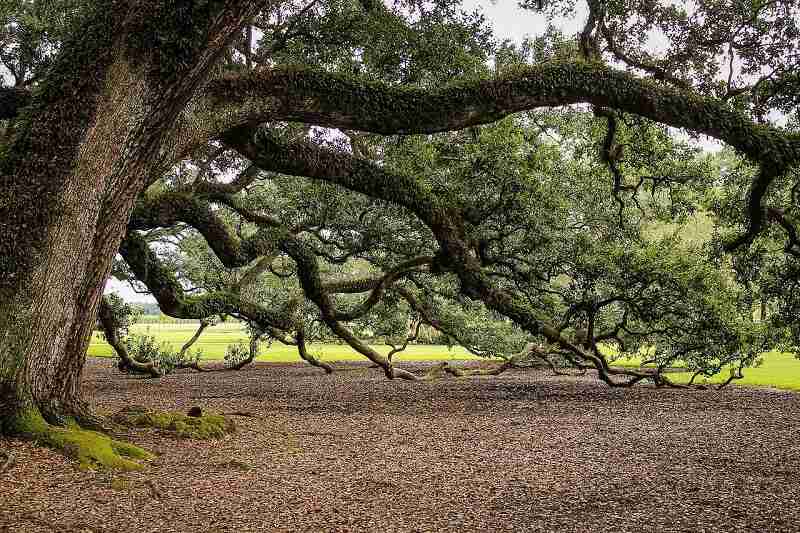
Photo Credit: Pixabay
Southern live oak is a picturesque shade tree straight out of a famous novel. Its branches sprawl up to 60 feet high and 100 feet wide, while its trunk grows up to 6 feet in diameter. These impressive trees live for hundreds of years when planted with enough room to thrive.
Southern live oaks love well-drained, moist soil. With regular pruning while young, these large trees become incredibly wind-resistant, making them an excellent addition to a hurricane-ready landscape.
Growth habit: Tree
USDA hardiness zone: 8a-10b
Mature size: Up to 60 feet tall and 100 feet wide
Duration: Perennial
Foliage: Evergreen
Sunlight needs: Full sun to partial shade
Soil preferences: Adaptable; prefers moist, well-drained soil
Water needs: Young southern live oaks might need watering once a month except during winter when rainfall provides enough water; mature trees are very drought-tolerant and most likely won’t need any watering outside of rainfall
Potential hazards: Acorns and leaves are toxic to pets and cause gastrointestinal upset if ingested; surface roots can damage nearby sidewalks, driveways, or other pavement
21. Southern Magnolia (Magnolia grandiflora)
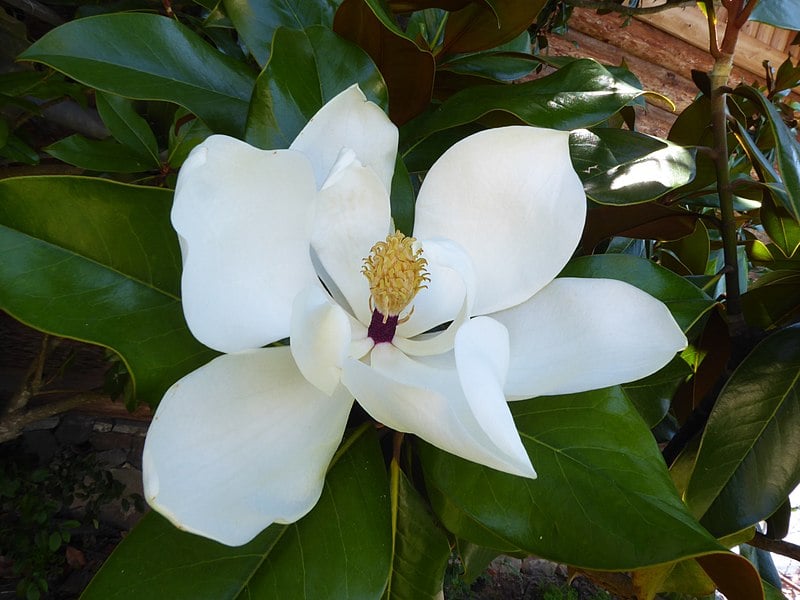
Photo Credit: Syrio / Wikimedia Commons / CC BY-SA 4.0
Southern magnolias have shiny, evergreen leaves and creamy white flowers up to a foot in diameter. These large trees grow up to 90 feet tall and produce a lemon-like fragrance. They make a great addition to privacy screens and boundary establishments and respond well to pruning and branch training.
Southern magnolias thrive in the sandy Ocala soils, preferring well-drained, moist, acidic soils. They grow in full sun to partial shade. It is important to note that these large trees grow best as perimeter plants as they shed leaves and seedpods every spring.
Growth habit: Tree
USDA hardiness zone: 7-9
Mature size: Up to 90 feet tall and 50 feet wide
Duration: Perennial
Foliage: Evergreen
Sunlight needs: Full sun to partial shade
Soil preferences: Adaptable; prefers moist, well-drained, acidic soil
Water needs: Young southern magnolias need watering one to two times weekly for the first six months; mature trees are drought tolerant and only need watering during extreme drought
Potential hazards: Non-toxic; no safety hazards; surface roots can damage nearby sidewalks, driveways, or other pavement
22. Southern Wax Myrtle (Myrica cerifera)
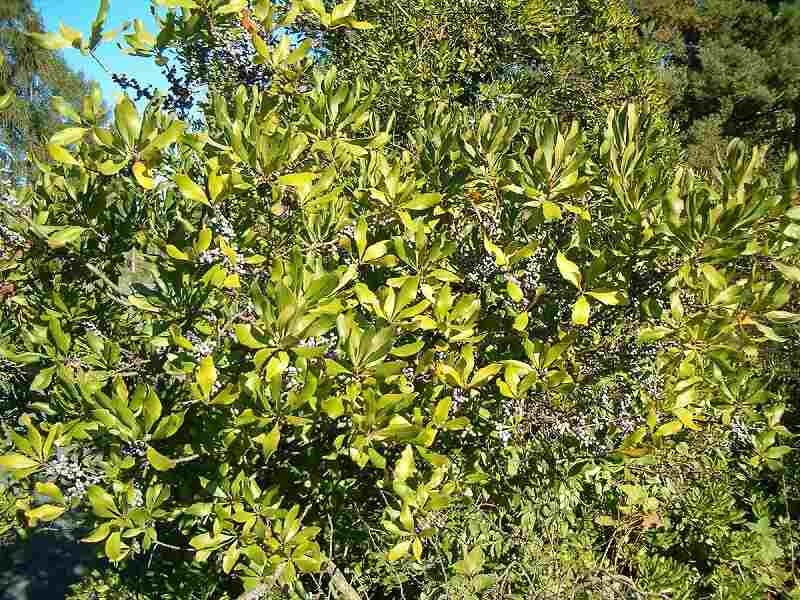
Photo Credit: BotBln / Wikimedia Commons / CC BY-SA 3.0
Southern wax myrtle is a small tree or large shrub that makes a great hedgerow or windscreen around Ocala properties. It is salt-tolerant and multi-stemmed with a round canopy. Southern wax myrtles are quick-growing and respond well to pruning and branch training.
These trees produce fragrant green flowers, glossy leaves, and gray bark. Wax myrtles adapt to a range of soils, including the acidic, sandy soils of Florida, and grow well in full sun to full shade.
Growth habit: Tree or shrub
USDA hardiness zone: 7b-11
Mature size: Up to 25 feet tall, but often kept shorter than 12 feet in landscapes; up to 25 feet wide at the crown
Duration: Perennial
Foliage: Evergreen
Sunlight needs: Prefers full sun or partial shade but tolerates full shade
Soil preferences: Adaptable
Water needs: Water once every 10-14 days in the absence of rain
Potential hazards: Non-toxic; no safety hazards
23. Star Jasmine (Jasminum nitidum)
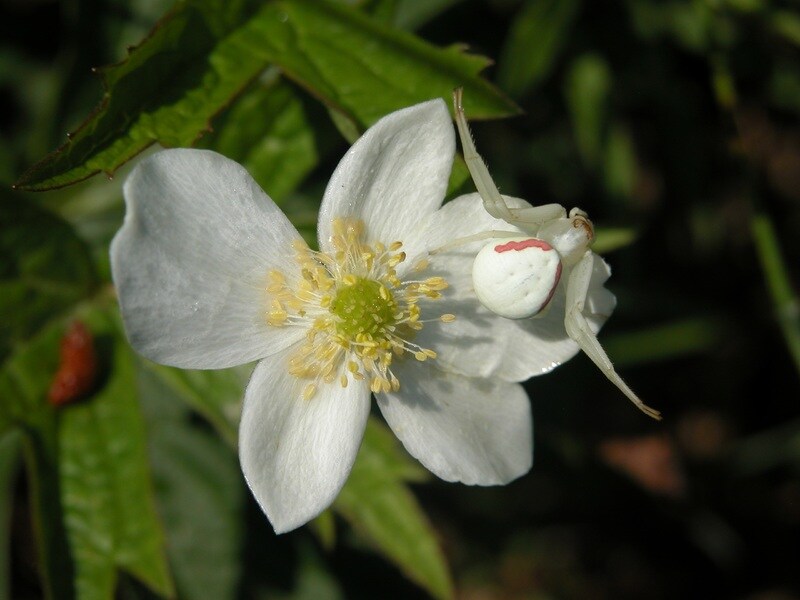
Photo Credit: Pxhere
Ocala’s subtropical climate creates the perfect environment for crawling vines. Star jasmine, also known as jessamine and evening trumpet flower, is a fragrant flowering vine with clusters of tiny white flowers that bloom in early spring and summer, attracting pollinators to your yard. It is moderately salt-tolerant, drought-resistant, and shade-tolerant.
Star jasmine is fast-growing and spreads to occupy any available space. It works well as groundcover but requires frequent pruning. The flowering vine is best planted near lampposts, trellises, arbors, or chain-link fences, and will not climb masonry walls or wooden fences without supports.
Growth habit: Vine or spreading groundcover
USDA hardiness zone: 9-11
Mature size: 10-15 feet tall and 3-4 feet wide
Duration: Perennial
Foliage: Evergreen
Sunlight needs: Full sun to partial shade
Soil preferences: Prefers moist, well-drained soil
Water needs: Drought-tolerant; may need weekly watering during extreme dry spells
Potential hazards: Non-toxic; no safety hazards
24. Walter’s Viburnum (Viburnum obovatum)
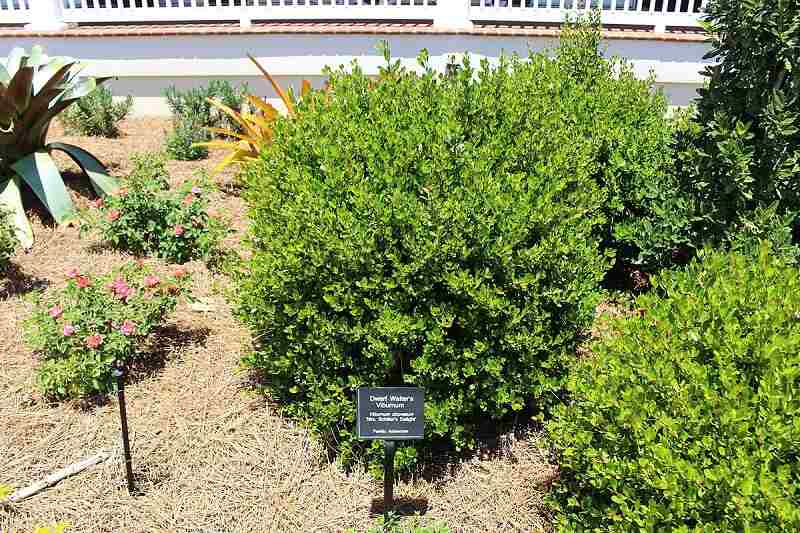
Photo Credit: Michael Rivera / Wikimedia Commons / CC BY-SA 4.0
Walter’s viburnum is another small tree that works well in Ocala landscapes as a large shrub. It has small white flowers that attract butterflies and fruits that ripen in fall, attracting birds and other wildlife. Walter’s viburnum reaches heights up to 20 feet tall but responds well to pruning and training, making it a great option for hedgerows and privacy screens.
The flowering tree has dense foliage that acts as a nesting spot for songbirds, and it is the host plant for the Azure butterfly. It is drought tolerant and prefers full sun to partial shade. These plants do not tolerate salt and need moist, well-drained soil.
Growth habit: Tree or shrub
USDA hardiness zone: 7-10
Mature size: 10-20 feet tall and 10-15 feet wide
Duration: Perennial
Foliage: Evergreen
Sunlight needs: Full sun to partial shade
Soil preferences: Prefers well-drained, moist soil
Water needs: Drought-tolerant; water twice weekly
Potential hazards: Non-toxic; safe for humans and animals
25. Yucca (Yucca spp.)
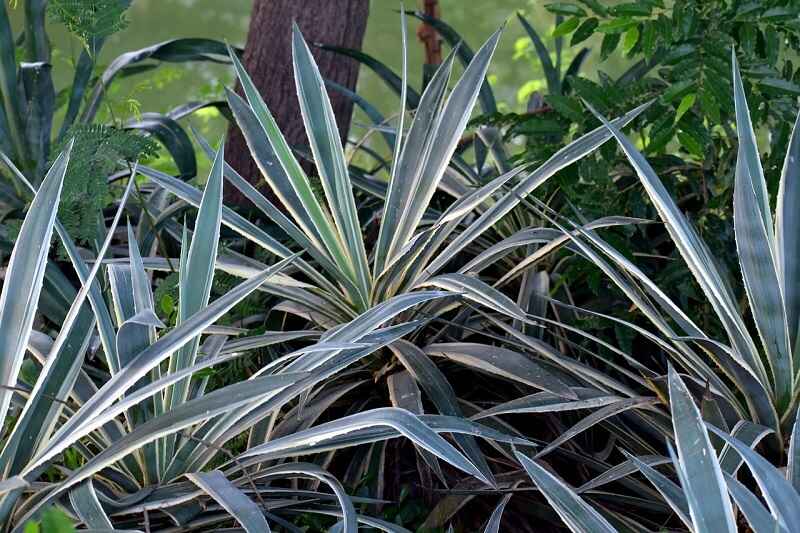
Photo Credit: Pixabay
Yucca plants are a group of Florida shrubs that love full sun and the fast-draining, sandy soils found in Ocala. They are extremely drought and heat-tolerant. Yucca plants grow well in flower beds, and their spiky foliage makes a great standalone specimen plant.
There are three native Yucca species in Florida:
- Adam’s needle (Yucca filamentosa): Bulbous white flowers bloom for several weeks every summer among sharp, spear-shaped leaves covered in hairy filaments.
- Moundlily yucca (Yucca gloriosa): Sharp, spine-tipped leaves grow from a central rosette and upright clusters of white flowers grow tall, up to 6 feet, above the foliage.
- Spanish bayonet (Yucca aloifolia): This species produces clusters of bell-shaped white flowers and sharp, spear-shaped leaves that fan out in a circular pattern. Flowers bloom from spring to late summer.
Growth habit: Shrub
USDA hardiness zone: 5a-10b
Mature size: 2-10 feet tall and 2-6 feet wide
Duration: Perennial; some species are annuals
Foliage: Evergreen
Sunlight needs: Full sun
Soil preferences: Adaptable; prefers well-drained soil and does not tolerate heavy clay soil
Water needs: Drought-tolerant; water every 10 days
Potential hazards: Moderate toxicity; poisonous to humans and animals when consumed raw; edible when cooked
How to Choose Native Plants for Your Ocala Yard
Not all native plants grow well in your Ocala yard and each has their own needs. It is important to consider your landscape’s needs, including soil type, irrigation access, and sun and shade conditions, and select plants suitable for your unique microclimate.
Ocala sits in USDA Hardiness Zone 9a, indicating the coldest annual temperature is between 20 to 25 degrees Fahrenheit. Florida-native plants are cold-hardy to the minimum temperature in Ocala’s hardiness zone. Keep your zone in mind when selecting non-native plants for your landscape.
FAQ About Native Ocala Plants
Thanks to Ocala’s year-round subtropical climate, you can plant anytime you want. Plants go through their active growing season in spring and summer. Experts agree the best time to head into your garden is from mid-March to the beginning of April.
Early morning is the best time to water your plants. Foliage needs time to dry before nightfall, and wet foliage can lead to disease and rot. Winds are calmer and temperatures are lower in the early morning, so there is less risk of water loss from evaporation or sun scorching.
Native plants support beneficial insects like butterflies, bees, and birds as well as Florida’s ecosystem. Many are salt and drought-tolerant and adapted to the acidic, sandy soil found in most North Central Florida yards, making them easier to grow.
Where to Find Native Plants in Ocala
Create your own home forest complete with fragrant blooms, hanging vines, and warm-season turfgrass to invite butterflies and songbirds into your yard by introducing native plants. Be sure to source your plants ethically from reputable nurseries.
Check out these local Ocala nurseries:
Many native plants are drought and wind-tolerant, standing up to dry summers and high winds. Be sure to create a landscape maintenance plant to care for your new native plants and turfgrass year-round. Check out our spring lawn care tips to get you started.
If you need help deciding which native plants to add to your landscape, let Wikilawn connect you with a local Ocala landscaping pro.
Main Image Credit: Jasmine flower / Wallpaperflare